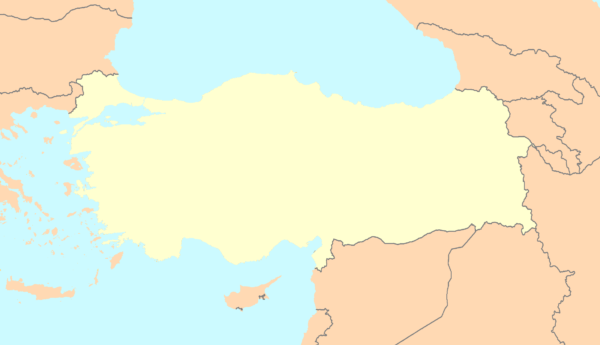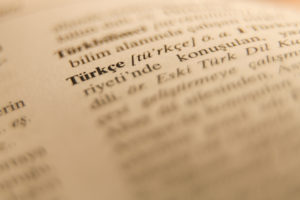Discover the Secrets of the Turkish Language
Turkish is the official language of Turkey. This country is unique because it sits on the border between Europe and the Middle East. And the language reflects this cultural divide. It has a fascinating history and roots that may surprise you. Find out everything from basic facts to the writing system of the Turkish language. Who knows, maybe this will be your motivation to start learning Turkish.
Basic Facts About the Turkish Language
There are 75 million native Turkish speakers worldwide. And that’s just for Turkish. There are other languages closely related to Turkish that are sometimes called the same language, but a different dialect. These languages are Azerbaijani and Turkmen. If we count these languages along with Turkish, then Turkish has up to 110 million speakers in the world.
The Language Family of Turkish
Turkish is a very unique language, and you can tell that just by looking at its language family. It’s part of the Turkic language family, which means it’s related to Azerbaijani, Turkmen, and Qashqai. There are debated theories that Turkish is part of the Altaic language family. That would tie it as a relative of Mongolian, Korean, and Japanese. But, these claims don’t have sufficient evidence, so they’re usually disregarded.

The History of the Turkish Language
The Turkish language descended from Proto-Turkic roots. The ancestors of Turkish people migrated from Central Asia to the land that is Turkey today. By the time these Turkic people arrived in Anatolia, the language developed into Oghuz Turkic. This migration ended with the Seljuc Empire in the 11th century CE.
The Seljuc Empire adopted Islam, which meant that they also adopted Arabic as their liturgical language. But, the administrative and the everyday language remained Turkish. But, Turkish was written using Arabic letters.
The Language During the Ottoman Empire
From the Seljuc Empire rose the Ottoman Empire. This is the same Turkish nation that defeated half of Europe in the Middle Ages. Their official language was Turkish, but it was highly influenced by Persian and Arabic. This was especially true for vocabulary and grammar. The name of the Turkish they spoke in the Ottoman Empire was unsurprisingly Ottoman Turkish. Ottoman Turkish was only the language of the elite, the common people spoke a different dialect.
The Modernization of the Turkish Language
The most important event in the history of the Turkish language was Mustafa Kemal Atatürk’s reform. He was the first president of the Republic of Turkey. In 1923, he began a standardization and linguistic revolution of the Turkish language. And the biggest part of this reform was the change in the writing system.
To this point, the Turkish language was written using Arabic letters. But, this didn’t fit the Turkish language well. Since the Arabic alphabet is an abjad (a writing system without vowels), Turkey needed its own alphabet. So, in 1923, Turkish switched to the Latin alphabet. The same letters used in English. Granted, with some modifications to account for pronunciaiton differences.
These reforms meant a standardization of the Turkish language in the administrative sector too. And the literacy rate in the country skyrocketed.

Turkish Dialects
As mentioned before, Azerbaijani and Turkmen are almost the same languages as Turkish. Sometimes, they’re even considered the same, or dialects of each other. That’s because they’re mostly mutually intelligible.
Here’s a fascinating historical fact for you: Azerbaijani (or Azeri Turkish) was actually called Turkish. During the Soviet occupation, the Soviet Union renamed the language. They did this to separate them from Turkey ideologically. The similarity between Turkish and Azerbaijani is around 60%. So, they are considered mutually intelligible.
The Alphabet of the Turkish Language
Today, Turkish only uses the Latin alphabet. This means that learners who are native English speakers have a considerable advantage. You’ll know almost all the letters of the Turkish alphabet instantly. But, there are a few letters that are added variations to the familiar ones. This is to reflect the Turkish pronunciation well. There are 29 letters in the Turkish alphabet.
A a |
B b |
C c |
Ç ç |
D d |
E e |
F f |
G g |
Ğ ğ |
H h |
I ı |
İ i |
J j |
K k |
L l |
M m |
N n |
O o |
Ö ö |
P p |
R r |
S s |
Ş ş |
T t |
U u |
Ü ü |
V v |
Y y |
Z z |
As you can see, “Ç”, “Ş”, “Ğ”, “I”, “İ”, “Ö”, “Ü” are modified letters to fit the Turkish pronunciation better. Occasionally, there are also some circumflexes on top of vowels (â, î and û). These also either signal a pronunciation change or they differentiate from other, similar-looking words.
You may have noticed that Q, X, and W aren’t a part of the Turkish alphabet. That’s because these letters don’t appear in Turkish words naturally. But, you may find them in foreign names and loanwords.
Turkish Numbers
Learning Turkish numbers is easy because they use the same counting system as English does. Since English uses Arabic numbers too, counting in Turkish is fairly straightforward.
sıfır |
bir |
iki |
üç |
dört |
beş |
altı |
yedi |
sekiz |
dokuz |
on |
0 |
1 |
2 |
3 |
4 |
5 |
6 |
7 |
8 |
9 |
10 |
Turkish Grammar
You may think that learning Turkish means you’ll have to deal with impossibly hard grammar. But, that’s not true. Turkish grammar is fairly straightforward, very systematic, and quite consistent. And since Turkish is almost entirely phonetic, reading and pronouncing Turkish will be easy. Here are some important rules that give a good overview of Turkish grammar.
- Usually, a vowel follows a consonant. Two vowels or two consonants together is rare.
- Vowel harmony is important: specific vowels are grouped together when you speak Turkish
- When you attach a suffix to a proper noun, you need to separate the suffix and the noun with an apostrophe.
- Turkish has an SOV (subject-object-verb) sentence structure.
- Non-continuant voiceless consonants (p,ç,t,k) are sometimes voiced to make words easier to say
- ‘y’,’n’ and ‘s’ are buffer letters. They prevent two vowels to come after each other.
Does Turkish Have Genders?
You’ll be glad to hear that Turkish doesn’t have any genders. This is always welcome news for students learning Turkish. So, that makes learning Turkish a lot easier for sure. But, when you’re using Turkish nouns, you need to think about what suffix you’re going to use after them. That’s because Turkish is an agglutinative language.
Turkish Agglutination
What does the agglutinative language mean? This means that you can add different suffixes to words to change their meaning. While in English you’d express an idea by describing it with several words, you can often say the same thing in Turkish with one long word instead. Most often, agglutination in Turkish shows plurality, grammatical case, or possession. Here’s an example:
- house – ev
- in the house – evde
- your house – evin
- in your house – evinde
So by adding “-de”, you say “in”, and by adding “-in” you mean “your”. And if you put “-inde” together, that means “in your”. Sometimes, agglutination can lead to incredibly long words like:
- muvaffakiyetsizlestiricilestiriveremeyebileceklerimizdenmissinizcesine – as if you were one of those we might not be able to fail

The Grammar Behind Turkish Suffixes
Suffixes are letter combinations that attach to the end of a noun to change its meaning. Once you learn the most important suffixes in the Turkish language, fluency will be much easier to achieve. Here are the most common Turkish suffixes to get you started.
Turkish Suffixes |
English Equivalent |
Example |
-li |
with or
with the quality of or belonging to |
köylü = “villager”
sulu = “with water” atlı = “horseman” |
-siz |
without |
susuz = “without water” |
-çi, -ci |
profession |
gazeteci = “journalist”, çaycı = “tea seller”, dişçi = “dentist” |
-[y]ici |
habit |
yazmak = “to write”, so yazıcı = “writer” |
-çe |
-ish or as for |
çocukça = “childish[ly]”
türkçe = “Turkish” bence = “as for me” |
-(i)msi,
-(i)mtrak, -si |
-ish or -like |
duvarımsı = “wall-like”
beyazımtrak = “whitish” çocuksu = “child-like” |
-daş |
fellow- |
okuldaş = “schoolmate”
-daş does not follow vowel harmony |
-lik |
abstract noun formation |
büyüklük = “largeness” or “size”
susuzluk = “waterlessness” or “thirst” Granted, susuzluk is rather stilted, a Turk would more likely ask “Susadın mı?” for “Are you thirsty?” |
-igde, -ligi |
of the, similar to -lik |
|
-sel |
abstract adjective formation |
tarih = “history”, tarihsel = “historic” |
-ki |
abstract adjective formation |
sabahki hava = “morning weather”
Amerikadaki çocuklar = the children in America Ahmet’inki = “Ahmet’s” (with possessive) |
-ki |
added to genitive case to form a possessive pronoun |
Bu kalem benimki değil. = “This pencil is not mine (I do have a pencil, but this one is not it).”
Bu köpek benimki. = “This dog is mine.” |
-çik, -cik, -ceğiz, -ce |
Diminutive |
Ahmetçik = “my pal Ahmet”
Köyceğiz = “the dear little village” and a lakeside town in southwestern Turkey. |
-[y]iş |
Add to a verb stem for the noun form |
girmek = “to enter”, so giriş = “entrance”
çıkmak = “to exit”, so çıkış = “exit” |
-leyin |
by or at |
geceleyin = “by night”
akşamleyin = “at evening” |
-ken |
while |
yazarken = “while writing” |
-oğlu |
son of |
Köseoğlu Bey = “Mr Son-Of-The-Beardless-Man” |
Keep in mind that this isn’t an exhaustive list of all Turkish suffixes. If you want to learn even more, you can find them here.

Turkish Vowel Harmony
Now that you know about agglutination and suffixes in Turkish, let’s take a look at how you attach these suffixes to the words. There’s an art to it, and it’s called vowel harmony.
Every noun has vowels. So, when you’re attaching suffixes to nouns, you need to match the sound of these vowels. Clearly, you’re not going to change the noun to fit the suffix. So, you use a different version of the suffix to match the noun. Here’s a clear example of vowel harmony in Turkish:
If you want to use the suffix -li = with / belonging to, you need to change the vowel in it to keep the vowel harmony:
- köylü = “villager”
- sulu = “with water”
- atlı = “horseman”
As you can see, -li changed to -lü and -lu to match the vowel of the noun.
Turkish Cases
Cases show what function a word fulfills in a sentence. So, this means that when you put a noun in the sentence, its form may change depending on where it is in the sentence. There are 6 cases in the Turkish language. Here are some examples of how a noun is typically conjugated if they’re in that case:
Turkish Cases |
Example Word |
Meaning |
nominative |
ev |
the house (subject) |
genitiv |
evin |
of the house (possession) |
dative |
eve |
to the house (indirect object) |
accusative |
evi |
the house (direct object) |
ablative |
evden |
from the house |
locative |
evde |
in/on the house (location) |
How Hard Is Turkish to Learn?
There’s no such thing as a hard thing to learn. And the Turkish language is definitely not hard. But, having the right language learning method can definitely make it easier.
Officially, Turkish is a Category 4 language in terms of difficulty. This ranking was given by the US Foreign Service Institute (FSI). They examined how fast native English speakers could learn the language. On average, that number came to 1100 hours. From zero knowledge to full fluency.
But, you can actually achieve that much faster. A government agency doesn’t know you, your motivation, and what language learning method you’re using. So, you can take the FSI estimates with a grain of salt.
Why Should I Learn Turkish?
There so many reasons to learn Turkish. For one, if you speak Turkish, you can talk to the 75 million native Turkish speakers in the world. That’s 75 new potential friends. But, you can also make traveling to Turkey a lot easier. You can ask for directions and get recommendations from locals normal tourists only dream about.
But, speaking Turkish can positively affect your everyday life too, not just your vacations. Speaking a second language looks amazing on a CV. And bilingual employees are reportedly earning more money. Plus, we can’t forget about the health benefits of speaking Turkish either. You can keep your brain sharp and actually fight dementia and Alzheimer’s better at old age. Talk about the incredible perks of learning Turkish!
Discover the Turkish Language with OptiLingo
As you can see, Turkish is a wonderful and exciting language. And it’s waiting for you to learn it. If you have dreams of reaching fluency in Turkish, sharing tea with locals, and discovering the beauty of Turkey comfortably, you need OptiLingo.
OptiLingo turns your dreams of speaking a second language into reality. It’s an app that’s specifically designed to make you speak the language as fast as possible. How? By only focusing on the most essential Turkish vocabulary. You don’t need to waste time learning words you’ll never use. Learn the same phrases Turkish locals use every day instead. To achieve Turkish success fast download OptiLingo today!









